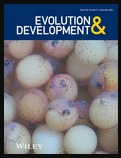“The trilobite head served multiple functions and was composed of several fusedsegments. Yet, the underlying organization of the trilobite head, and whetherpatterns are conserved across trilobites, remains unclear. Modeling the head asbeing composed of modules, or subunits that vary and thus have the potentialto evolve semi‐independently can reveal underlying patterns of organization.Hypotheses of modular organization based on the comparative developmentalbiology of arthropods were evaluated using geometric morphometrics. Two‐dimensional (semi)landmark datasets collected from the cranidia of two Ordoviciantrilobite species,Calyptaulax annulata(Phacopida) andCloacaspis senilis(Olenidasensu Adrain, 2011) were analyzed. The degree and pattern of modularity wereassessed using the covariance ratio (CR), which compares the covariation withinputative modules to the covariation between them, and the fit of different modelswas compared using an effect size measure derived from the CR. When treating theeyes as a distinct module, the best modular hypothesis identified forC. annulatashows the eyes and anteriormost region of the head integrated as a single module.The best modular hypotheses forC. senilisare more complex but the eyes stillcovary mostly strongly with the anterior part of the head. The latter is also the caseforallotherwell‐supported models for both species. These results can beinterpreted as a developmental signal corresponding to the anteriormost ocularsegment of early arthropods that is retained throughout development, despite anylikely selective pressures related to functional needs.” Published in Evolution & Development

